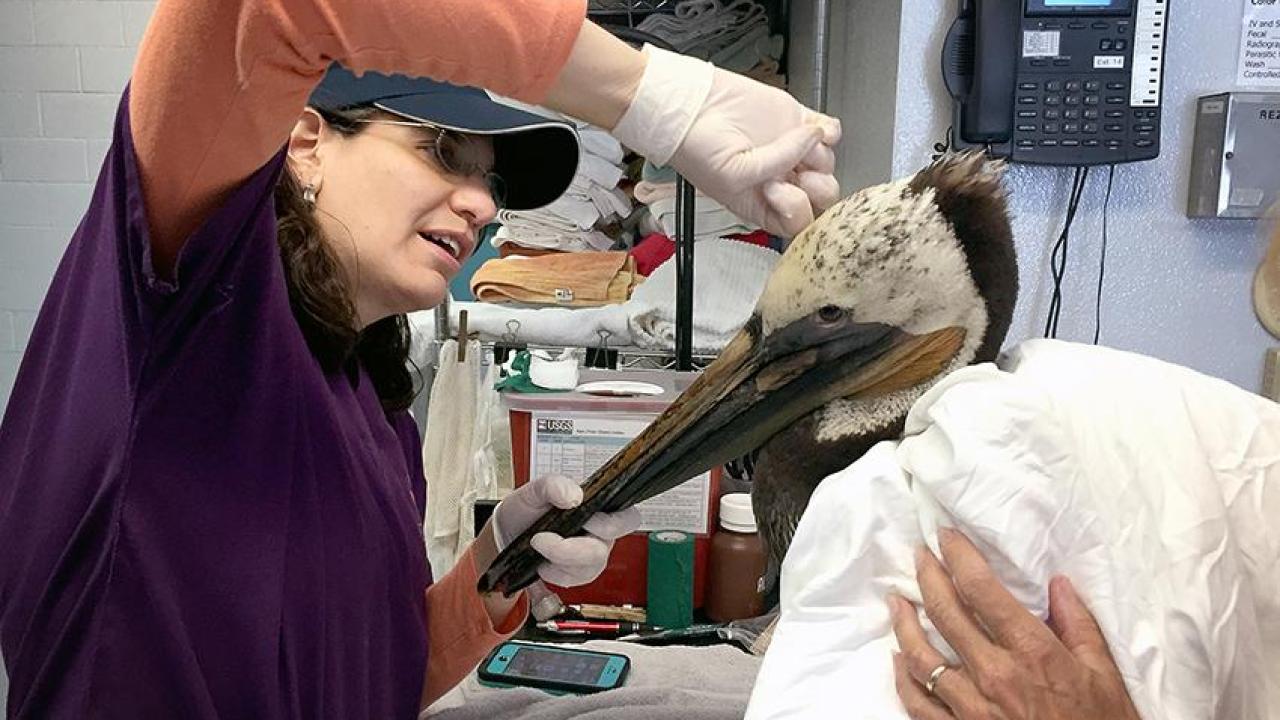
UC Davis Unit Aids Wildlife Rescue Effort
Update Thursday, May 28: As of 6 p.m. May 27, 39 birds — mostly brown pelicans — had been rescued, and 18 birds had beer collected dead. Sixteen California sea lions and six northern elephant seals had been rescued, while four dead dolphins and six dead sea lions had been collected. Oiled animals collected to date: 89.
Update Wednesday, May 27: As of 8 p.m. May 26, 33 birds had been rescued and 16 dead birds collected, and 18 mammals rescued and nine dead mammals collected. Rescuers said most of the birds are brown pelicans. No marine mammals were captured on May 26. Twelve California sea lions and six northern elephant seals had been rescued previously.
Update Tuesday, May 26: UC Davis' Oiled Wildlife Care Network reports 25 birds rescued —- mostly brown pelicans — and 13 bird deaths. There have been 18 marine mammals rescued (12 California sea lions and six northern elephant seals) and eight deaths (three dolphins and five California sea lions). One of the dolphins was determined to not be visibly oiled upon post-mortem examination. The remaining dead marine mammals have not yet been assessed for oiling.
Update Saturday, May 23: UC Davis' Oiled Wildlife Care Network reports eight birds rescued and five bird deaths, and three mammals rescued and one mammal death.
•••
Original news release, May 21: Team members from the Oiled Wildlife Care Network at UC Davis have joined crews responding to the oil spill in Santa Barbara County. They are coordinating the wildlife response effort as part of the unified command interagency emergency response team.
OWCN staff and faculty were called away from an oil spill conference in Alaska to respond today to the spill that released 105,000 gallons of crude oil in Santa Barbara County, with an estimated 21,000 gallons entering the water.
Five pelicans, one sea lion being treated
Five live oiled pelicans and one oiled California sea lion have been rescued as of 2 p.m. on May 21. The oiled birds are being transported to the Los Angeles Oiled Bird Care and Education Center, a facility roughly three hours south of Santa Barbara in the San Pedro community. The facility is designed to care for up to 1,000 birds that have been coated with, swallowed or inhaled oil.
Operated by International Bird Rescue, the 12,000 square-foot center has specialized areas for wildlife intake, holding, washing, drying, isolation and recovery, as well as for food preparation, medical care and necropsy.
The sea lion is being transferred to the Oiled Wildlife Care Center at SeaWorld San Diego. The 2,600 square-foot center, completed in 2000, is capable of housing up to 200 seabirds and 20 marine mammals and can accommodate pinnipeds, sea turtles and sea otters.
Too soon to know wildlife impact
While the OWCN team assesses the situation, it is too early to estimate the full wildlife impacts. Updates will be posted on the OWCN blog, https://owcnblog.wordpress.com, as well as announced at regular briefings provided by the Unified Command Center.
“Just because there’s a lot of oil in the environment doesn’t mean we will have huge numbers of animals,” said Mike Ziccardi, director of the Oiled Wildlife Care Network at UC Davis. “Sometimes there are small spills with large numbers of animals and huge spills with just a few animals.”
The 2007 Cosco Busan oil spill, for example, released more than 53,000 gallons of fuel oil into the San Francisco Bay. Ziccardi directed the care of 1,068 oiled birds at that time.
“Right now, with a worst-case estimate at 105,000 gallons released, this spill would be twice the size of Cosco Busan, but we’re not yet seeing large numbers of affected wildlife,” Ziccardi said. “It’s not necessarily a linear relationship.”
Can take days for wildlife to get sick
It can take days for oiled wildlife to get sick and weak from ingesting oil or getting it on their skin or plumage. For example, oiled birds typically ingest oil when they attempt to clean their feathers, which can affect their immune systems, internal organs and reproductive systems. Oil on bird’s feathers also affects their ability to insulate themselves. As they lose body heat, they become hypothermic, and their need for food increases. Yet, due to the oil on their plumage, they do not float or fly well. Wildlife responders who find them collect them and transfer them to a wildlife rescue facility for treatment.
Members of the public who spot oiled wildlife should not try to pick them up and “save” them, OWCN urges, as this can cause the animals further harm. Rather, they should report oiled wildlife immediately by calling 1-877-UCD-OWCN.
Oil funds for oiled wildlife rescue
The OWCN is managed by the UC Davis Karen C. Drayer Wildlife Health Center, which is part of the UC Davis School of Veterinary Medicine. The network is the world’s most advanced system of emergency centers for wild animals hurt in oil spills. It is funded by the California Department of Fish and Wildlife’s Office of Spill Prevention and Response. This funding comes from interest on the California Oil Spill Response Trust Fund, built from taxes levied on the oil industry.
Media Resources
- OWCN blog updates
- Office of Spill Prevention and Response, CalSpillwatch updates
- This story first appeared on UC Davis News
- Kat Kerlin, Research news (emphasis on environmental sciences), 530-752-7704, 530-750-9195 (cell), kekerlin@ucdavis.edu
- Joint Information Center media line, (805) 696-1188
